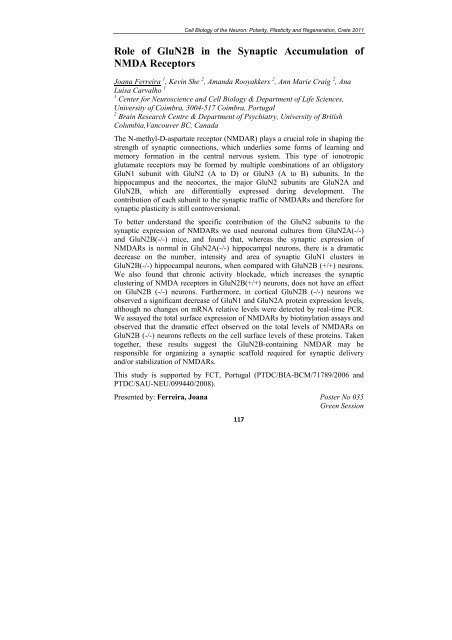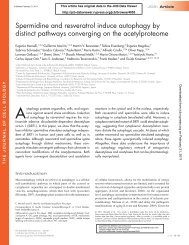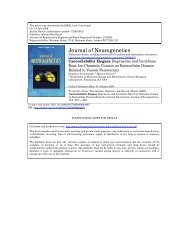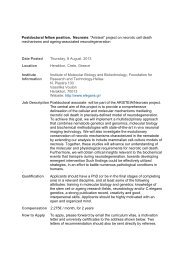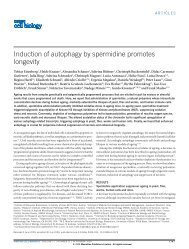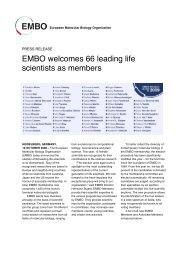CELL BIOLOGY OF THE NEURON Polarity ... - Tavernarakis Lab
CELL BIOLOGY OF THE NEURON Polarity ... - Tavernarakis Lab
CELL BIOLOGY OF THE NEURON Polarity ... - Tavernarakis Lab
You also want an ePaper? Increase the reach of your titles
YUMPU automatically turns print PDFs into web optimized ePapers that Google loves.
Cell Biology of the Neuron: <strong>Polarity</strong>, Plasticity and Regeneration, Crete 2011<br />
Role of GluN2B in the Synaptic Accumulation of<br />
NMDA Receptors<br />
Joana Ferreira 1 , Kevin She 2 , Amanda Rooyakkers 2 , Ann Marie Craig 2 , Ana<br />
Luísa Carvalho 1<br />
1<br />
Center for Neuroscience and Cell Biology & Department of Life Sciences,<br />
University of Coimbra, 3004-517 Coimbra, Portugal<br />
2<br />
Brain Research Centre & Department of Psychiatry, University of British<br />
Columbia,Vancouver BC, Canada<br />
The N-methyl-D-aspartate receptor (NMDAR) plays a crucial role in shaping the<br />
strength of synaptic connections, which underlies some forms of learning and<br />
memory formation in the central nervous system. This type of ionotropic<br />
glutamate receptors may be formed by multiple combinations of an obligatory<br />
GluN1 subunit with GluN2 (A to D) or GluN3 (A to B) subunits. In the<br />
hippocampus and the neocortex, the major GluN2 subunits are GluN2A and<br />
GluN2B, which are differentially expressed during development. The<br />
contribution of each subunit to the synaptic traffic of NMDARs and therefore for<br />
synaptic plasticity is still controversional.<br />
To better understand the specific contribution of the GluN2 subunits to the<br />
synaptic expression of NMDARs we used neuronal cultures from GluN2A(-/-)<br />
and GluN2B(-/-) mice, and found that, whereas the synaptic expression of<br />
NMDARs is normal in GluN2A(-/-) hippocampal neurons, there is a dramatic<br />
decrease on the number, intensity and area of synaptic GluN1 clusters in<br />
GluN2B(-/-) hippocampal neurons, when compared with GluN2B (+/+) neurons.<br />
We also found that chronic activity blockade, which increases the synaptic<br />
clustering of NMDA receptors in GluN2B(+/+) neurons, does not have an effect<br />
on GluN2B (-/-) neurons. Furthermore, in cortical GluN2B (-/-) neurons we<br />
observed a significant decrease of GluN1 and GluN2A protein expression levels,<br />
although no changes on mRNA relative levels were detected by real-time PCR.<br />
We assayed the total surface expression of NMDARs by biotinylation assays and<br />
observed that the dramatic effect observed on the total levels of NMDARs on<br />
GluN2B (-/-) neurons reflects on the cell surface levels of these proteins. Taken<br />
together, these results suggest the GluN2B-containing NMDAR may be<br />
responsible for organizing a synaptic scaffold required for synaptic delivery<br />
and/or stabilization of NMDARs.<br />
This study is supported by FCT, Portugal (PTDC/BIA-BCM/71789/2006 and<br />
PTDC/SAU-NEU/099440/2008).<br />
Presented by: Ferreira, Joana Poster No 035<br />
Green Session<br />
117


